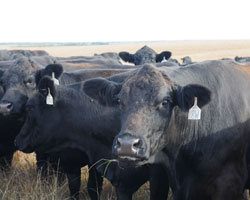Killer disease: May 11 meeting is planned to inform, coordinate response to anaplasmosis in cattle
The disease has been found beyond typical areas of eastern Kansas.
 Released: April 20, 2016
Released: April 20, 2016
MANHATTAN, Kan. – An unwanted visitor has arrived in parts of Kansas, and the results have been cattle death loss in some cases.
Anaplasmosis is a crippling, blood-borne disease carried by ticks and flies that can kill mature cattle if left untreated.
A May 11 meeting is planned in Salina to bring cattle producers, veterinarians, extension agents and others together to inform, educate and work toward a coordinated response to the disease, which surged into Kansas in 2015. The meeting starts at 11:30 a.m. at Kansas State University Polytechnic Campus’s College Conference Center, at 2310 Centennial Road.
The meeting is hosted by the Kansas State Veterinary Diagnostic Laboratory and K-State Research and Extension, and it involves beef-focused faculty from K-State’s College of Veterinary Medicine and College of Agriculture, plus leadership from the Kansas Livestock Association, Kansas Farm Bureau and Kansas Veterinary Medical Association.
“In 2015, almost every county in the eastern two-thirds and several far-west counties of Kansas had samples that were tested and found to be anaplasmosis positive,” said Gregg Hanzlicek, director of production animal field investigations for the Veterinary Diagnostic Lab, noting that it’s not unusual for the disease to be found in eastern Kansas but had not been so much a problem in western Kansas until recently.
“We don’t know if the geography of this disease has changed or if veterinarians and producers are looking harder for it, but it is clear that there are positive herds in a very large percentage of Kansas.”
Topics and speakers will include:
- Anaplasmosis in Cattle: Facts and Fiction — Gregg Hanzlicek, Veterinary Diagnostic Laboratory, Kansas State University, and Mike Apley, Frick Professor, Clinical Sciences, Kansas State University;
- Diagnostic Considerations and Strategies — Gregg Hanzlicek, Veterinary Diagnostic Laboratory, Kansas State University;
- Keeping Anaplasmosis out of your Cow Herd — Dave Rethorst, Veterinary Diagnostic Laboratory, Kansas State University, and KC Olson, Department of Animal Sciences and Industry, Kansas State University;
- Flies, Ticks, and Anaplasmosis in Kansas — Ram Raghavan, Diagnostic Medicine and Pathobiology, Kansas State University;
- Can I Vaccinate for Anaplasmosis? — Gene Luther, AgCenter, Department of Veterinary Science, Louisiana State University;
- Treating Individual Cows and Herds for Anaplasmosis — Mike Apley, Clinical Sciences, Kansas State University;
- The VFD and Anaplasmosis Infection — Bill Flynn, Deputy Director of Science Policy, Food and Drug Administration; and
- What will Anaplasmosis Infection do to Herd Productivity? — Max Irsik, Large Animal Clinical Sciences, University of Florida.
There is no cost to attend the symposium. Registration is required by May 6, as seating is limited.
For more information or to register, contact Anthony Ruiz in the K-State Research and Extension Central Kansas District office at 785-392-2147 or anruiz@ksu.edu.
Anaplasmosis facts:
MANHATTAN, Kan. – The Kansas State Veterinary Diagnostic Laboratory and K-State Research and Extension provided facts about anaplasmosis in cattle.
- Anaplasmosis bacteria live in red blood cells of cattle. Flies and ticks spread the bacteria when they ingest infected blood. Using needles contaminated with blood from infected animals can also transfer the bacteria.
- Anaplasmosis can infect animals of all ages, but only mature animals express clinical symptoms. They include sudden death, icterus (yellow appearance around the eyes or vulva), and aggression or excitability. If left untreated, some mature cattle with anaplasmosis will die. However, the organism is susceptible to appropriate doses of oxytetracycline (OTC).
- Almost every county in the eastern two-thirds of Kansas and several far-western counties had cattle that tested positive for anaplasmosis in 2015.
- There have already been confirmed cases of the disease in cattle in Kansas in 2016.
To register for a May 11 meeting in Salina to learn more about anaplasmosis and how to combat it, contact Anthony Ruiz in the K-State Research and Extension Central Kansas District office at 785-392-2147 or anruiz@ksu.edu.
-30-
K‑State Research and Extension is a short name for the Kansas State University Agricultural Experiment Station and Cooperative Extension Service, a program designed to generate and distribute useful knowledge for the well‑being of Kansans. Supported by county, state, federal and private funds, the program has county Extension offices, experiment fields, area Extension offices and regional research centers statewide. Its headquarters is on the K‑State campus in Manhattan.
For more information:
Anthony N. Ruiz - 785-392-2147 or anruiz@ksu.edu
